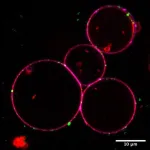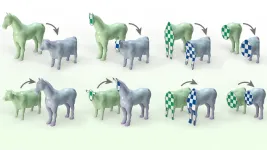(Press-News.org) To know when it’s time for a meal – and when to stop eating again – is important to survive and to stay healthy, for humans and animals alike. Researchers at the Max Planck Institute for Biological Intelligence investigated how the brain regulates feeding behavior in mice. The team found that the hormone ghrelin activates specialized nerve cells in a brain region known as the amygdala. Here, the interaction between ghrelin and the specialized neurons promotes food consumption and conveys hunger and the pleasant and rewarding feelings associated with eating.
Hunger is a powerful sensation with important biological underpinnings. It signals the body to look for food, which is a crucial behavior to prevent starvation and ensure survival. When we’re hungry, we crave for food – and when we finally get to eat, our body rewards us with pleasant feelings and a general state of happiness.
A network of brain circuits and signaling pathways orchestrates the eating behavior of humans and animals and elicits the associated sensations. One of the central players in this network is the hormone ghrelin. It is released by stomach cells when humans and animals are hungry or fasting, and promotes feeding behavior.
The department of Rüdiger Klein at the Max Planck Institute for Biological Intelligence studies the brain networks that underly feeding behavior in mice. To this end, the researchers conducted a thorough analysis of the different cell types in a brain region known as the central amygdala. “Previously, the amygdala had mostly been studied in the context of feelings like fear and reward, while the regulation of feeding was thought to happen in different parts of the brain, such as the hypothalamus,” says Christian Peters, a postdoctoral researcher in the department.
Nine cell clusters
Peters and his colleagues analyzed individual cells in the central amygdala, studying messenger RNA molecules – the cell’s working copies of their genes. The analysis revealed that the cells are organized into nine different cell clusters. Some of these clusters promote appetite while others inhibit it, and they adjust their production of messenger RNAs when the mice are fed or fasting.
“We now have a much better understanding of the diversity of cell types and the physiological processes that promote feeding in the central amygdala,” says Rüdiger Klein. “Our research uncovers for the first time that the ‘hunger hormone’ ghrelin also acts on cells in the central amygdala.” There, it activates a small subset of cell clusters, collectively marked by the presence of the protein Htr2a, to increase feeding.
Multiple functions for ghrelin
The scientists found that the Htr2a neurons became active after an overnight fast or when stimulated by the hormone ghrelin. The cells also responded when the researchers presented food to the mice. “We think that ghrelin performs multiple functions,” explains Christian Peters. “When mice are hungry, ghrelin activates the appetitive brain regions to predispose the animals for eating. In addition, the hormone enhances the activity in brain circuits, such as the amygdala, that confer rewards, which is likely an incentive to eat additional food.” This way, ghrelin increases the palatability of food in proportion to how satiated the mice currently are.
After a fasting diet, when the animals were very hungry the activity of Htr2a neurons was not needed to start feeding, presumably because the tastiness of food is less important under these conditions. “Other brain circuits, for example the hypothalamus, which regulate the body’s metabolism, take over and signal the mice that it’s important to eat in order to survive,” says Christian Peters.
Feeling hungry or satiated has profound impacts on physical but also on emotional wellbeing, as probably everyone knows by the pleasures associated with eating tasty food. “The neuronal networks that convey these feelings are obviously linked to those that control eating, yet it is not fully understood how exactly they influence each other,” says Rüdiger Klein.
“If we figure out these connections, we will better understand the neuronal processes that are involved in pathological eating behaviors, such as overeating,” concludes Christian Peters. “There are numerous biological factors that contribute to such a complex behavior and we have to look at the physiological processes to understand these factors.” Ultimately, this knowledge might lead to novel therapeutic approaches to alleviate eating disorders. For now, the research lays the groundwork for further studies to investigate how specific neuron populations are involved in the neuronal circuits that control feeding. It also adds another important piece to the puzzle of understanding how the brain orchestrates behavior.
END
How tasty is the food?
A hormone and specialized brain cells regulate feeding behavior in mice
2023-05-24
ELSE PRESS RELEASES FROM THIS DATE:
Discovery slows down muscular dystrophy
2023-05-24
A team of researchers at the University of Houston College of Pharmacy is reporting that by manipulating TAK1, a signaling protein that plays an important role in development of the immune system, they can slow down disease progression and improve muscle function in Duchenne muscular dystrophy (DMD).
DMD, caused by mutations in dystrophin gene, is an inheritable neuromuscular disorder that occurs in one out of 3,600 male births. DMD patients undergo severe muscle wasting, inability to walk and eventually death in their early thirties due to respiratory failure. The ...
A novel method to quantify individual limb contributions to standing postural control
2023-05-24
Research question
Can these contributions to standing postural control be quantified from CoP trajectories in neurotypical adults?
Methods
Instantaneous contributions can be negative or larger than one, and integrated contributions sum to equal one. Proof-of-concept demonstrations validated these calculated contributions by restricting CoP motion under one or both feet. We evaluated these contributions in 30 neurotypical young adults who completed two (eyes opened; eyes closed) 30-s trials of bipedal standing. We evaluated the relationships between limb contributions, self-reported limb dominance, and between-limb ...
NASA data could lead to more accurate weather forecasts
2023-05-24
A University of Texas at Arlington civil engineering researcher will use a NASA grant to help forecasters better predict extreme weather events using a variety of existing NASA data sources.
Yu Zhang, associate professor in the Department of Civil Engineering, said the $638,000 grant will use ocean circulation data, atmospheric conditions and current weather information to make longer-range forecasting more reliable. Having a more accurate forecast could help officials make better decisions about the state’s water resources—for example, knowing when to release water from reservoirs.
“Using ...
Digital engineering to reduce risks that lead to brain injuries
2023-05-24
A University of Texas at Arlington engineering researcher who studies traumatic brain injuries has received funding to use computer motion simulation that replicates the movements of a person performing activities that could lead to injury.
The project, funded by a nearly $1 million grant from the Office of Naval Research Defense University Research Instrumentation Program (DURIP), will use real-time data of phantom head and phantom body reactions to ascertain what physical injuries could come from those motions.
Ashfaq Adnan, a UT Arlington professor in the Department of Mechanical and Aerospace Engineering, is leading the project, called “System for Remote ...
A look into the heart of cellular waste disposal
2023-05-24
To prevent our body’s cells from overflowing with garbage and to keep them healthy, the waste inside them is constantly being disposed of. This cleaning process is called autophagy. Scientists have now, for the first time, rebuilt the complex nanomachine in the laboratory that starts this process – and it works quite differently from other cellular machines. The researchers’ new insights could help open up new approaches for the treatment of cancer, immune disorders, and neurodegenerative diseases in ...
Designing a next generation hypersonic demonstrator
2023-05-24
Today, large commercial jets fly around 580 mph. The Lockheed SR-71 Blackbird introduced in 1966 is the fastest supersonic jet vehicle in the world, reaching speeds of more than 2,200 mph, nearly four times faster than a commercial jet.
The fastest rocket-powered hypersonic vehicle developed in the late 1960s carrying a human has been the North American X-15, reaching a top speed of 4,520 mph, twice that of the SR-71.
Recently, the U.S. Air Force has awarded a contract to engineer Project Mayhem with the goal to reach 4,603 mph. Now, imagine a vehicle that could fly much faster, maybe even above 6,905 mph, which is beyond nine times the speed of sound.
The University of Texas at Arlington’s ...
Confusion over VAERS: Why the vaccine safety reporting system should be renamed
2023-05-24
PHILADELPHIA – The federal health system for reporting “adverse events” after vaccination, known as VAERS, is designed to assist in the early detection of complications and responsive action. But when the pandemic and advent of new vaccines for Covid-19 turned a spotlight on this formerly little-known system, the flood of web and social media references to it was accompanied by confusion about what the system is and what the reports in it signify.
A new report from the Annenberg Public Policy Center examines misconceptions about the government’s Vaccine Adverse ...
A better way to match 3D volumes
2023-05-24
CAMBRIDGE, MA — In computer graphics and computer-aided design (CAD), 3D objects are often represented by the contours of their outer surfaces. Computers store these shapes as “thin shells,” which model the contours of the skin of an animated character but not the flesh underneath.
This modeling decision makes it efficient to store and manipulate 3D shapes, but it can lead to unexpected artifacts. An animated character’s hand, for example, might crumple when bending its fingers — a motion that resembles how an empty rubber glove deforms rather than the motion of a hand filled with bones, tendons, ...
Chemical Insights Research Institute and the Campus Safety, Health, and Environmental Management Association publish guidance for the safe use of 3D printing in institutions of higher education
2023-05-24
Atlanta (May 24, 2023) - Chemical Insights Research Institute (CIRI) of UL Research Institutes and the Campus Safety, Health, and Environmental Management Association (CSHEMA), announce the publication of, “UL 200B: Guidance Document for Safe Use of 3D Printing for Institutions of Higher Education.”
The availability of 3D printing has fostered creative and innovative learning experiences for many within the large population of students in higher education. There are roughly 17.3 million undergraduates in the U.S. alone. Because 3D printers are affordable compact, and user friendly, they can ...
SWI/SNF complexes “bookmark” cell identity during division
2023-05-24
(Memphis, Tenn.—May 24, 2023) When a cell divides, it retains information about how to grow and instructions about what type of cell to become. Scientists at St. Jude Children’s Research Hospital have gained a new understanding of how these processes can work, revealing a previously unappreciated role for the SWI/SNF chromatin remodeling complex. The study was published today in Nature.
When a cell undergoes differentiation, stem cells (the earliest cells that develop) undergo changes that transform them into a different type of cell, typically one with a more specialized function (such as a skin or muscle cell). As ...
LAST 30 PRESS RELEASES:
New study reveals major gaps in global forest maps
Ochsner Health names Dr. Timothy Riddell executive vice president and chief operating officer
Can future-focused thoughts help smokers quit?
From brain scans to alloys: Teaching AI to make sense of complex research data
Stem Cell Reports seeks early career editors to join the editorial board
Signs of ancient life turn up in an unexpected place
Pennington Biomedical researchers explore factors behind body’s ability to regulate weight
Zhongping Lee awarded the Nils Gunnar Jerlov Medal
Deborah S. Kelley awarded the Wallace S. Broecker Medal
Novel immunotherapy demonstrates early potential to overcome resistance to immune checkpoint therapy
LLM treatment advice agrees with physician recommendations in early-stage HCC, but falls short in late stage
Deep learning model trained with stage II colorectal cancer whole slide images identifies features associated with risk of recurrence – with higher success rate than clinical prognostic parameters
Aboard the International Space Station, viruses and bacteria show atypical interplay
Therapies that target specific type of cell death may be an effective avenue for cancer treatment, UTHealth Houston researchers find
CHEST releases guideline on biologic management in severe asthma
Scientists create a system for tracking underwater blackouts
Fruit fly pigmentation guides discovery of genes that control brain dopamine and sleep
World's largest physics conference to be held in Denver and online this March
New mega-analysis reveals why memory declines with age
Understanding ammonia energy’s tradeoffs around the world
UTHealth Houston researchers map gene disruptions in sporadic early onset Alzheimer’s disease across key brain regions
Minimum wage increases are linked to safer pregnancies
Left in the cold: Study finds most renters shut out of energy-saving upgrades
This crystal sings back: Illinois collaboration sheds light on magnetochiral instability
Organisms in the Atacama Desert soil are remarkably diverse
Children’s Hospital Colorado research outlines first pediatric classifications for suicide risk in adolescents and kids
No thyme wasted: Harnessing the medicinal benefits of thyme extract With small doses
Fat surrounding the colon interacts with the immune system
Genetic predisposition to excess body weight and survival in women diagnosed with breast cancer
New mechanism links Epstein-Barr virus to MS
[Press-News.org] How tasty is the food?A hormone and specialized brain cells regulate feeding behavior in mice








